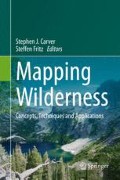Abstract
This chapter presents the first spatially explicit wilderness map for the Austrian territory. This is modelled using the spatial patterns of four aspects of wilderness, an approach developed by the Australian Heritage Commission: remoteness from settlements, remoteness from access, apparent naturalness and biophysical naturalness. In order to combine these four layers we applied two approaches, which reflect two different aspects of wilderness quality, namely a weighted overlay and a minimum operator. These two approaches were merged to gain a spatially explicit estimation of the wilderness continuum for all of Austria. By applying two different thresholds to the continuum, we identified core as well as extended areas, which can be considered as wild areas with high potential for wilderness. In total 1.98 % and 6.16 % of the country can be classified as core and extended areas, respectively. The vast majority of these areas are located in mountain regions with higher elevations occurring especially in the western parts of Austria. Despite some shortcomings of this approach, e.g. the lack of data describing extensive land use like grazing, we hope that this assessment can serve as a policy- and management relevant tool to improve wilderness quality in Austria.
Access this chapter
Tax calculation will be finalised at checkout
Purchases are for personal use only
References
Carver, S., Evans, A., & Fritz, S. (2002). Wilderness attribute mapping in the United Kingdom. International Journal of Wilderness, 8, 24–29.
Carver, S., Comber, A., McMorran, R., & Nutter, S. (2012). A GIS model for mapping spatial patterns and distribution of wild land in Scotland. Landscape and Urban Planning, 104, 395–409.
Dudley, N. (Ed.). (2008). Guidelines for applying protected area management categories. Gland: IUCN.
EEA-ETC/LUSI. (2007). CLC2006 technical guidelines (EEA technical report 17). Luxembourg: Office for Official Publications of the European Communities. Available at: http://www.eea.europa.eu/publications/technical_report_2007_17. Accessed 11 July 12.
ESRI. (2011). ArcGIS desktop: Release 10. Redlands: Environmental Systems Research Institute.
Fisher, M., Carver, S. Kun, Z., McMorran, R., Arrell, K., & Mitchell, G. (2010). Review of status and conservation of wild land in Europe. Project commissioned by the Scottish Government.
Fritz, S., Carver, S., & See, L. (2000). New GIS approaches to wild land mapping in Europe. In S. F. McCool, D. N. Cole, W. T. Borrie, & J. O’Loughlin (Eds.), Wilderness science in a time of change conference – Volume 2: Wilderness within the context of larger systems (pp. 120–127), Missoula.
Geofabrik. (2012). OpenStreetMap-Shapefiles. Available at http://www.geofabrik.de/data/shapefiles.html. Accessed 18 Sept 2012.
Grabherr, G., Koch, G. Kirchmeir. H., & Reiter, K. (1998). Hemerobie österreichischer Waldökosysteme. Innsbruck: Österreichische Akademie der Wissenschaften, Veröffentlichungen des österreichischen MaB-Programms.
Jarvis, A., Reuter, H. I., Nelson, A., & Guevara, E. (2008). Holefilled seamless SRTM data V4. International Centre for Tropical Agriculture (CIAT). Available at http://srtm.csi.cgiar.org. Accessed 2 Aug 2012.
Kaissl, T. (2002). Mapping the wilderness of the Alps – A GIS-based approach. Diploma thesis at the University of Vienna, Vienna.
Kohler, B., Laßnig, C., & Zika, M. (2012). Wildnis in Österreich? Herausforderungen für Gesellschaft, Naturschutz und Naturraummanagement in Zeiten des Klimawandels. Purkersdorf: Österreichische Bundesforste AG (ÖBf AG), Kompetenzfeld Naturschutz.
Kopecky, M., & Kahabka, H. (2009). Updated delivery report European mosaic. Available at http://www.eea.europa.eu/data-and-maps/data/eea-fast-track-service-precursor-on-land-monitoring-degree-of-soil-sealing-100m-1. Accessed 14 Sept 2012.
Kuiters, A. T., van Eupen, M., Carver, S., Fisher, M., Kun, Z., & Vancura, V. (2013). Wilderness register and indicator for Europe final report (p. 92). EEA Contract No: 07.0307/2011/610387/SER/B.3.
Lesslie, R., & Maslen, M. (1995). National wilderness inventory: Handbook of principles, procedures and usage (2nd ed.). Canberra: Australian Heritage Commission.
Lesslie, R. G., & Taylor, S. G. (1985). The wilderness continuum concept and its implications for Australian wilderness preservation policy. Biological Conservation, 32(4), 309–333.
Lesslie, R. G., Mackey, B. G., & Preece, K. M. (1988). A computer-based method for the evaluation of wilderness. Environmental Conservation, 15, 225–232.
Nash, R. (2001). Wilderness and the American mind (4th ed.). New Haven/London: Yale University Press.
Secretariat of the Convention on Biological Diversity. (2010). Global biodiversity outlook 3. Montréal: Secretariat of the Convention on Biological Diversity.
Umweltbundesamt. (2012). Skigebiete 2008. Available at http://www.umweltbundesamt.at/umweltsituation/umweltinfo/opendata/oed_naturschutz/. Accessed 14 July 2012.
Walder, C., & Litschauer, C. (2010). Ökomasterplan Stufe II – Schutz für Österreichs Flussjuwele! Zustand und Schutzwürdigkeit der österreichischen Fließgewässer mit einem Einzugsgebiet größer 10 km 2. Wien: WWF Österreich.
Wild Europe Initiative. (2012). A working definition of European wilderness and wild areas. Available at http://www.panparks.org/sites/default/files/docs/iyw/Definition-of-wilderness-for-Europe.pdf. Accessed: 16 Feb 2013.
Acknowledgements
This work was supported by the European Research Council Starting Grant 263522 (LUISE) and contributes to the Global Land Project (www.globallandproject.org).
Author information
Authors and Affiliations
Corresponding author
Editor information
Editors and Affiliations
Rights and permissions
Copyright information
© 2016 Springer Science+Business Media Dordrecht
About this chapter
Cite this chapter
Plutzar, C., Enzenhofer, K., Hoser, F., Zika, M., Kohler, B. (2016). Is There Something Wild in Austria?. In: Carver, S., Fritz, S. (eds) Mapping Wilderness. Springer, Dordrecht. https://doi.org/10.1007/978-94-017-7399-7_12
Download citation
DOI: https://doi.org/10.1007/978-94-017-7399-7_12
Published:
Publisher Name: Springer, Dordrecht
Print ISBN: 978-94-017-7397-3
Online ISBN: 978-94-017-7399-7
eBook Packages: Earth and Environmental ScienceEarth and Environmental Science (R0)

